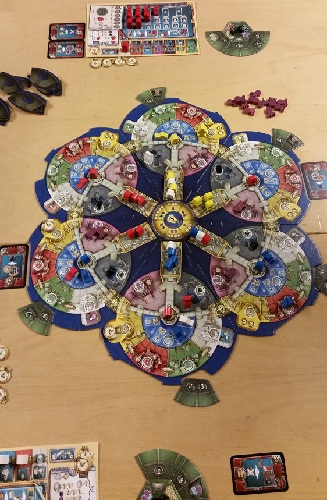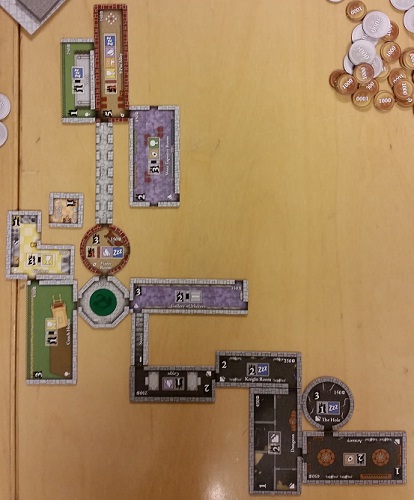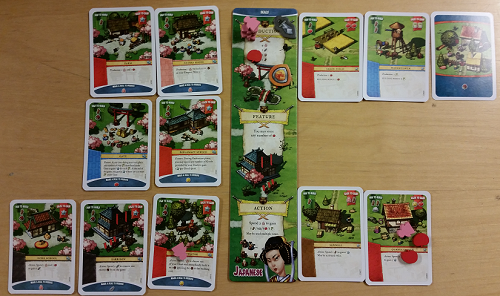Well, I made it. Now I have list of games I would play in pretty decent order. The last 10 games are just super-awesome games and eventually I think I will own all of these. They have a solid place in my collection.
10. Suburbia (2012) 
Designer: Ted Alspach
This game has pretty similar backstory as Sun, Sea & Sand. My first playtested game back in 2007 was modular hex-tile city building game with hexes having different actions when placed. The basic premise is pretty much what Suburbia is about. I might someday go back to the first design as it has had now seven revisions and sparked up few other ideas. The topic however is Suburbia. It took me 5 games before I played with the rules intended. The last mistake I made was that all the tiles were in play and not the randomly selected subset it should be. This mistake was revealed to me after I had read the expansion manual. This made the game long and scores were also very high. But somehow I really liked this game. It had a good flow going on, the balancing act of money and points is very well executed and now that the tiles are limited the game time is perfect for a quick great game.
9. Patchistory (2013) 
Designers: Yeon-Min Jung & Jun-Hyup Kim
I’m little baffled that Patchistory isn’t higher up in the BGG ranking. It features quite an unique way of playing. I know only a handful of games which feature the lay on top mechanism and this is definately the most heaviest of them all. The game is played with 3×3 cards that form your own little patch of history. The cards are double-sided which increases the plays this game offers. The interaction is also there with action for the cards and then there is also caravans which Wanderer between the neighbouring players. Fighting and wars are included but unlike in Through the Ages losing doesn’t keep you from contending. Great civ-game with unique game play. Patchistory is going to have a second printing and I presume that it will become more popular.
8. Village (2011) 
Designers: Inka Brand & Markus Brand
Definately one of best action selection games out there. The mechanism of distributing different amounts of cubes in different action locations is brilliant. It allows many possibilities as the cubes are different colors they can have different effects. The balance of actions available between different player numbers is nicely handled with this mechanism as is the set collection aspect of the cubes also. What other thing Village does nicely is the aging of the workers. This is done so the players can score points. Ultimately it is a very good thematic representation of a workers life. It also brings one thing I like in my worker placement games is that each player has their own number of workers. This of course brings another balance issue to the game but nevertheless is a thing I really like seeing in games. There is a lot of going on this small Village and with the expanions the game just keeps rebreathing life to itself.
7. Nations (2013) 
Designers: Rustan Håkansson, Nina Håkansson, Einar Rosén & Robert Rosén
This one was a small surprise, to be found this high on the list, for me. When I got to think about it I knew that it belongs there. I only have played three games of Nations which just be the reason it is here. The learning how to play is over and now I want to use the game as my sandbox. Nations has resolved many issues with civ-games with the card system it employs. The growth of your civilization is based on the risks you take and plans you make right at the beginning of your turn. Do you take another worker? Can you feed it and support it, does it contribute enough in you civilization? Then the card “auction” distributes the cards to players, this is one point which could be handled better as the distribution might be off sometimes but in the games I played I have no complaints. Wars and fighting is done in a satifying way. There is no direct conflict which annoys me in these types of games, instead there is a card that any player can buy. The military power of that player marks the number which must be matched to avoid penalties. There are great combos in this game and ways to play that I have just begun to understand. I would really like to play it more. Eventually though I can see this one dropping quite fast in the list but at the moment this is the right place.
6. Agricola (2007) 
Designer: Uwe Rosenberg
One of the most iconic worker placement games in the last ten years is still going strong in the minds and tables of gamers. Uwe made farming known to the world by introducing the card game Bohnanza, but Agricola made farming in boardgames popular. Agricola also features a throng of cards and to get your games going don’t draft, just draw 7 and play. There is just enough angst when playing and you experience a challenging little bump which you need to climb before your game starts going. As there is a negative feedback mechanism as you must feed your workers six times during the game and those feeding are crucial to achieve points. After you get your gaming going there is only joy what you feel playing Agricola. I don’t know what else I can say about Agricola as there is a lot of resources for it out there. If you haven’t played it, play it as soon as possible. Jump in the deep end and enjoy.
5. Tichu (1991) 
Designer: Urs Hostettler
Tichu is a partnership/trick-taking game with a slightly modified deck of card. The point is to be the first player to get rid of your hand and the winning pair is the one with 1000 points. The setup for each round is that before 8 cards each player can declare Grande Tichu (200 points), which means that you declare that you’re going to win this round. After all the cards are dealt but before any cards are played each player gives and receives one card from all other players. It is also possible to declare Tichu (100 points) before you have played your first card. I have grown to love Tichu and at the moment could play it every gaming session I have. I don’t what it is about Tichu but during playing it keeps me constantly thinking about the situation and also my partner. It is rare partnership game I care about. The success to winning is to have good cards to yourself but you need also be selfless and sometimes give your best card to your partner. The order how you play your cards and the combinations which you can have are crucial and sometimes plans just don’t work how you would like them to go. Excellent game that fulfills all my trick-taking needs. Because Tichu I also want to try out Haggis and Chimera.
4. Russian Railroads (2013) (should play soon) 
Designers: Helmut Ohley & Leonhard “Lonny” Orgler
It seems that many games in my top10 are quite new games that I have only started to test out. I have only played Russian Railroads once. What I gathered from that game is that the worker placement elements with the many tracks and special powers work great together and the game enjoyment is similar to Agricola. I obtained this to myself after the first play and I’m very sure that before the year is at end I have played more Russian Railroads. This is a thinking game with many strategy possibilities and great worker placement elements. The more I think about this the more I want to play it.
3. Caverna: The Cave Farmers (2013) 
Designer: Uwe Rosenberg
Agricola was first published in 2007 and last year the re-implementation of it came out. Uwe tried many things with the resource collection aspect and then came back to the first thing he came up in Agricola. Caverna could be the first step onwards on the worker aspect on these types of games. Your workers can be turned into warriors which then can take additional actions in various levels. The building of your caverna and farms are somewhat similar to Agricola with the distinction that there are no more cards with actions but small selection of tiles with actions. Caverna isn’t as tight with its negative feedback feeding as Agricola and you can enjoy your leisurely stroll in the worker placement realm with just a little bit of worry. I haven’t played enough Caverna to see what the tiles can do when comboed precisely and this just might be the reason why Caverna is number three on this list.
2. Keyflower (2012) 
Designers: Sebastian Bleasdale & Richard Breese
The best to-date from the Key-series definately. There is some much right done with this game that it is just absurd. First of all the game is quite short but packs so much game into it that you don’t even notice that you completed your game. The way the game is constructed is that there are four turns which represent the seasons of the year. Each turn there are hexes turned up which have actions printed on them. In addition of those hexes, which represent different buildings, there are ship hexes that bring workers to the realm; hence the name Keyflower. First there is auction done with your workers. There are three basic workers (blue, red and yellow) and green workers. Auctions are simple most mechanic bids that allows players to calculate how they want to use their workers during their turns. The same workers used in the bid could be used for actions later on the turn. The colors are important as the other bids for that hex can only be done with the same color throughout the phase. Bids are done also for turn order which is crucial as the first player also gets to choose which ship and the accompanying workers/tiles he takes. I have found that the more workers you have at your disposal the better, so fighting for the position is important.
The second part of your turn is a basic worker placement phase when you’re doing action shown on the hexes. These are resource collection, converting resources, moving resources and etc. The point here being that you want a selection of resources onto a hex so you can upgrade it. The upgrading brings points at the end of game and is very important. The resources move rather slowly so upgrading you carts is important. The worker placement is also handled beautifully in Keyflower as you can use other players hexes and choose with which color to use them. Other players cannot use them with different colors and also further uses of hex tiles requires additional workers on them. There is also the thing that if you other players hexes the worker you use go to the other players pool for the next round. Brilliant I would say, you have to ask that is an action worth it everytime. This done four times and at the end of the fourth round an additional scoring is done and the layout of your plot affects that greatly. I presume that this game remains a constant source of entertainment for me and will dangle in the top 10 for long time.
1. Steam (2009) 
Designer: Martin Wallace
Steam has been on the top of my want to play list for many many years. I only have 23 games under my belt. I have all except the latest expansions to this game and will purchase the latest in Essen. The map expansions 2 and 3 have taken the game play little away from the original and haven’t been my favourites unlike the basic map and the expansion 1. Steam has it ancestral root in Age of Steam and if you recall the reason I like Steam better is the exclusion of the dice element and the fact that all the options are visible right from the start.
The setup is simple as you randomly allocate different colored cubes on the map and the object of the game is to transport said cubes to their own colored cities, if possible through as long routes as possible. When player transports a cube he gains either one step on the money track or one victory point for each link he uses. So, Steam is a train game of sorts.The thing I like the most about Steam is that you must have a gameplan from the first turn until the end of game and the flow of the game dictates if you’re able to do what you wanted to do.
You cannot escape the feeling that the game makes you think. For example, at the start of each turn you have the option to take step down on the money track. Each step gives you 5 money which you use to bid for turn order and build links on the map. The loan taking mechanism is crucial as you have to pay each turn for each loan you have. You must plan that you take enough and not a penny more. The problem arises right after the loan taking as turn order is done by bidding. There are moments when it is absolutely crucial to be in the first two positions. After the bid turn order is changed for the turn and once again a decision point is given.
There are 7 different tiles and players must take one for the turn. The tiles give you an action or an benefit for the turn. They are; passing once in the next turn bid, deliver goods or build track first, build four instead of three track pieces, place new cubes onto a city, increase your locomotive and build a new city. The game has been designed so that each tile has its place and the importance of each tiles fluctuates during the game. The tiles which gives the option to place new cubes are crucial at the beginning as it is the one which lets you increase your locomotive number. Those become obsolete at the end of game where you locomotive is at the peak and there are no more cubes to place. Then it is more important to deliver goods first.
Well, once the tiles have been chosen players build three track pieces trying to connect towns and cities on the map. As you want as many link as possible you try to build the track in one continuing line. There is blocking options available but usually the blocking is not blocking per se. It is just you didn’t build before the other player. Both would have gained equally on the track and the turn order becomes crucial. The base maps are rather forgiving in the beginning of the game and players usually start distant to each other. When the middle game begins there is a big mess and everybody is trying to cover the same cities as everybody else.
The cube delivery happens after the track laying. This is done twice in one turn. One cube at a time. If you don’t want to or can’t to deliver you can once increase your locomotive number per turn. The point here being that for the last two to four turns you ought to have cubes which can be delivered with five or six links. For the first four/five turns players usually take the money as with each link they can step up one spot on the money track. It is a huge deal to get on the positive side as it opens more options for you. I mean that when you have more money you can compete on the turn order bid which lets you have all the goods things before anybody else. The cube delivery is also the cruelest point of the game. All players can take the cubes on any city if they at least equal amount of links towards the delivery city. Meaning that sometimes players can do suboptimal actions to hurt your intentions. Sometimes it is just better to get 4 money/points than nothing at all. If at the same time the other player loses a 6 money/point delivery all the better.
The end of the turn is just for paying interest which is equal to your position on the money track + locomotive number. The money track goes to 10 and the locomotive track to 6, meaning that with everything maxed player can only have 4 money interest to himself. Which means the loan taking is important even at the end of the game.
There is just so much to like about Steam. I just rambled on about it here and I presume that there isn’t much coherency on those paragraphs above. Anyway, Steam is my number one want to play but it definately is also one of the best games for me.
Maybe I should have had a blog post just for Steam. This went rather long but there you have it. My what to play list of games. Did you read them all? What did you think about the list? What games are missing from the list? Please comment.
The following weeks I try to keep my post so that on monday I will have a Gaming diary-post and on friday there will be a changing topic post. First one will be Prototyping: Hedeby. Have a nice weekend and come back on monday.

















































































